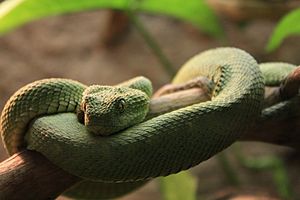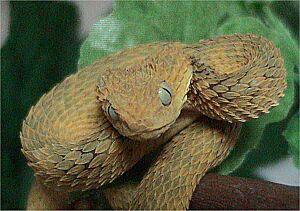Atheris facts for kids
Quick facts for kids Atheris |
|
|---|---|
 |
|
| A Variable Bush Viper, A. squamigera | |
| Scientific classification | |
| Kingdom: | |
| Phylum: | |
| Subphylum: | |
| Class: | |
| Order: | |
| Suborder: | |
| Family: | |
| Subfamily: | |
| Genus: |
Atheris
|
Atheris snakes are a group of venomous snakes called bush vipers. They live only in the warm, wet rain forests of tropical Africa, south of the Sahara Desert. Many types of Atheris snakes live in small, separate areas because they need rainforests to survive.
Contents
- Where Do Bush Vipers Live?
- How Big Are Atheris Snakes?
- What Do Atheris Snakes Look Like?
- How Do Atheris Snakes Compare to Others?
- What Do Bush Vipers Eat?
- How Do Atheris Snakes Reproduce?
- Are Atheris Snakes Dangerous to Humans?
- Conservation Status of Atheris Snakes
- Interesting Facts About Atheris Snakes
- See also
- Images for kids
Where Do Bush Vipers Live?
Atheris snakes live in tropical Africa, but not in the very southern part. They love rainforests and other forests where it is warm and wet. Some types of Atheris are found only in small, isolated parts of old rainforests. This means their homes used to be bigger, but now they are only in a few special spots.
How Big Are Atheris Snakes?
Atheris snakes are quite small compared to many other snakes. The smallest one, called Atheris katangensis, grows to about 55 centimeters (22 inches) long. The biggest one, Atheris squamigera, can reach up to 78 centimeters (31 inches). That is still shorter than many other snakes you might know!
What Do Atheris Snakes Look Like?
- Head: Atheris snakes have a wide, triangle-shaped head that stands out from their neck.
- Scales: Their heads are covered in small scales.
- Eyes: They have fairly large eyes with pupils shaped like ovals.
- Body: Their bodies are thin and a bit flat.
- Back Scales: The scales on their backs overlap and have ridges, making them feel rough.
- Tail: Their tails are strong and can grip onto branches, helping them climb.
- Colors: Atheris snakes come in many different colors and patterns. Some types, like Atheris ceratophora and Atheris squamigera, are especially colorful and beautiful.
How Do Atheris Snakes Compare to Others?
Atheris snakes show something cool called "convergent evolution." This means they look and act similar to other snakes that live far away, like the tree-dwelling pit vipers in Asia and South America. Even though they are not closely related, they have developed similar features to be good at living in trees. It is like different groups of animals found the same good solution to the same problem!
What Do Bush Vipers Eat?
Atheris snakes eat small animals. Their diet includes amphibians (like frogs), lizards, rodents (like mice), birds, and sometimes even other snakes. They are ambush predators, meaning they hide and wait quietly for their prey to come close. Then, they strike very quickly and hold on until their prey stops moving. After that, they swallow it whole! Some Atheris snakes prefer eating frogs, but most will eat whatever small animals they can find.
How Do Atheris Snakes Reproduce?
All Atheris snakes are viviparous. This means they give birth to live young, instead of laying eggs. They usually mate between September and November. The female snakes then give birth to their babies in March or April.
Are Atheris Snakes Dangerous to Humans?
Atheris snakes are known to be quite aggressive if disturbed. They mostly live in trees, but you can sometimes find them on the ground. However, they usually live far away from people, so they do not often interact with humans.
Conservation Status of Atheris Snakes
Some types of Atheris snakes are in danger. This is because their rainforest homes are being destroyed. When their habitats are cut down or damaged, they have fewer places to live and find food. This makes it harder for them to survive.
Interesting Facts About Atheris Snakes
- Atheris snakes have prehensile tails. This means they can use their tails to grip tightly onto branches, just like a monkey uses its tail.
- They are ambush predators. They hide and wait for their prey to come close before attacking.
- Some Atheris species can change their color. This helps them blend in with their surroundings, making it harder for predators and prey to see them.
- A common health problem for both pet and wild bush vipers is Snake Fungal Disease (SFD).
- The Variable Bush Viper is known to do very well when kept in zoos or by snake experts. They just need access to branches for climbing and do not have special temperature needs.
- In captivity, these snakes eat mice and small birds.
- There is no specific antivenom made just for Atheris snake bites. Antivenom meant for other snake bites often does not work well for Atheris bites.
See also
 In Spanish: Atheris para niños
In Spanish: Atheris para niños
Images for kids







